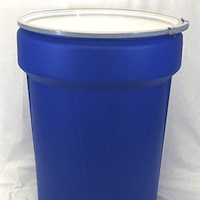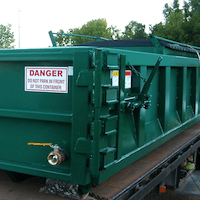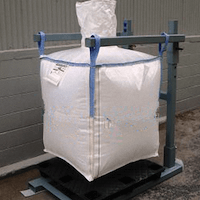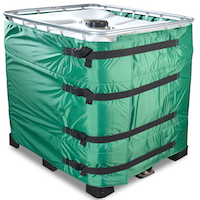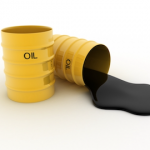Guest Blog:
by Mark Ceaser, Industrial Expert in Mercury Hazards and Control
MERCURY SPILL CONTROL PROCEDURES
It directly affects the central nervous and renal systems, causing developmental delays, motor and brain problems like those associated with autism. Mercury’s hidden danger also lies in when at room temperature, when exposed it vaporizes readily. Once it has become an aerosol, it is absorbed into the lungs and spreads throughout the body. Chronic mercury poisoning is more common due to long term exposure by inhalation of dust or vapors, and knowledge to prevent such incidents is vital in mercury collection and clean up.Mercury is a known neurotoxin that is extremely toxic even in small amounts.
Mercury is used in over 3000 industrial applications. The most common uses are in high-pressure sodium lamps and fluorescent bulbs, mercury-containing thermostats, spent batteries, in the medical field, with sphygmomanometers, fever thermometers and dental amalgams, and in chemicals and staining solutions, such as Mercury Chloride. Since the early 1990’s, environmental regulations have eliminated mercury as a produced product and sources now found are as a direct result of reclamation and recycling. Despite the changes in federal regulations to reduce the amount of mercury going into landfills and usages in products consumers use, mercury free alternative products have been slow to replace existing items, and in some case, impossible to do so. Knowledge of this situation makes educating people on the proper procedures and protection needed to clean up a mercury spill mandatory.
The most common form of a mercury spill is in liquid form. When liquefied, the small beads that form are difficult to pick up and contain, and measures should be taken accordingly to insure workers are protected and do not come in contact with the contaminated area without wearing proper protection. A broken light fixture, while not spread out, is just as much of risk to the employees as the dust very readily spreads and can be inhaled. Cleaning up this spill can be done in one of two methods, via amalgamation or insolubilization. Both methods will turn mercury in a non-vaporizing form. Insolubilization requires the mercury to be mixed into a sulfide, where amalgamation mixes the mercury with one or more metals into a solid, which is easier to collect and dispose. Three major surface areas that are encountered in spills are hard, such as concrete or tile, soft, such as carpet, and soils.
Before a spill takes place, the proper materials need to be in order for preventive maintenance. A spill kit should be on hand at any workstation where the risk of mercury spillage and exposure exists at all times. The kit should contain the following items: goggles, nitrile gloves, disposal bags, waste labels, storage container, mercury type respirator, mercury sensing badges or instruments, absorbent scratch pads, water spray bottle, shoe covers, warning tape and, preferably, zinc-ferrous based magnetic mercury amalgamation powder. Additional tools such as plastic, non-sparking shovels and sweeping devices, and a telescoping magnetic tool to collect the amalgam once hardened are recommended.
When a spill occurs, a set procedure should be followed to reduce the risk of exposure to the individuals, and spreading of the mercury from the spillage area. The first step when a spill occurs would be to isolate the contaminated area, evacuating all personal away from the building until the spill can be contained and corrected. The marking off of the area by tape or signs is followed by an immediate interview and spill inquiry report filled out with the workers assistance. This will determine whether the spill is a simple or complex spill. Generally, amounts under one pound of mercury are considered simple, with additional considerations taken to surface areas and spreading of the mercury.
Ventilation is the primary concern of the contaminated area, as the free mercury will readily vaporize and continue to do so until collected. It is recommended to shut down the air conditioning or heating, if applicable, and open the windows to get the maximum amount of air in the room and allow the vapors to flow outside.
After the process of applying personal protective equipment on and the removal of all metallic objects from the worker, use mercury sensing gauges or a gas vapor analyzer to determine the areas of contamination and residue. An alternative method is to use a high intensity halogen light to detect the presence of mercury droplets or powder. A final method would be the application of a Sodium Sulfide solution to the contaminated area. Discoloration in the form of dark reddish brown sta
in will indicate the presence of mercury.
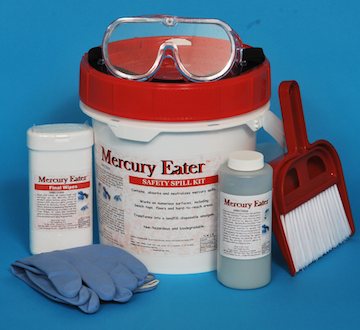
Once the mercury has been located, apply the magnetic amalgamation powder directly to the contaminated area. Using the spray bottle, apply a slight mist to the powder, to allow the dry acid reagent to react with the metals and start to form the solid bond. Mix the powder and mercury together, using the scratch pads until the metals have the appearance of a paste like substance. With normal setting times approximately an hour’s time, survey the entire area for additional contamination spots, making notice of cracks, crevices and any orifices the mercury could have fallen into. If detection has discovered mercury in such conditions, the advantages of the magnetic amalgamation powder are evident. In the same method as before, form a paste and apply to the area contaminated. Once hardened, use the magnetic pick up tool to collect the mercury bearing waste, and collect into a storage container. This application is also advisable to use in situations where mercury has accidentally been poured down a drain and unable to collect. Forming the powder and using the magnetic tool like a drain snake, collect the mercury, and remove the piping for disposal, along with the waste amalgam, at an approved mercury recycling and collection facility.
Upon completion of the spill area, collect all contaminated materials that have been amalgamated into a bucket with sealed lid. This container will be the primary device to return the objects to the mercury recycler. Inspect the area, and atmosphere for any residual indication of mercury vapors. The Occupational Safety and Health Administration (OSHA) standards limit the exposure risks to vapor to be no more than 0.2 mg/L. Great care must be taken to inspect all the areas before declaring the site now safe for return. Collection of the tools, gloves, boots, etc., can now be done and put into separate containers for disposal. A final protective application from any residual mercury would be to put down a wax like sealant over the surface area, if applicable.
Another common spill situation occurs when mercury has been spilled in a doctor’s office and winds up on carpeting. The same skill and observation to detail must be followed in order to complete the task. Application of the amalgamation powder, and then collection with a mercury only vacuum is the preferred method. The carpet area affected is then cut out and ripped up, with all items, including the vacuum cartridge, contaminated into disposal containers for return to the recycler. Again, as with the hardened surface area, vapor analyzing will indicate if additional treatment is needed.
Occasionally, mercury is spilled outside and into the surrounding soil. Great care must be taken to set up a perimeter around the contaminated area and to collect the soil for cleaning. Soils vary in type and consistency, and commonly, the mercury is found very close to the surface. The soil can be taken off site for reclamation via distillation or by using a combination of forming layers of the amalgamation powder and sand, making a slurry of the soil and water, and passing the mixture through the filter media. The effluent should be tested for mercury contamination and the filter media retained for processing at the recycler.
In dealing with any mercury spillage, a growing concern in recent years has been the proper disposal procedures concerning mercury-bearing wastes. This has greatly concerned legislative authorities on concerns of mercury returning into the ecosystem by improper disposal methods, such as landfill burial or illegal dumping. While stricter environmental regulations and development of new technologies to reduce the amount of mercury products, the EPA Greenlights program has set standards to have specified regulations for fluorescent bulb disposal and to reclaim the mercury. Other recycling policies concerning mercury-containing devices, such as thermostats, have enacted collection services for mercury devices for recycling. The standards and locations of such facilities, or information to set up a collection program, can be found at the Mercury Awareness Program web site or by contacting the Association of Lighting and Mercury Recyclers at www.almr.org.
This article appeared in the Summer 2012 issue of HazMat Management Magazine



 P.O. Box 8149
P.O. Box 8149